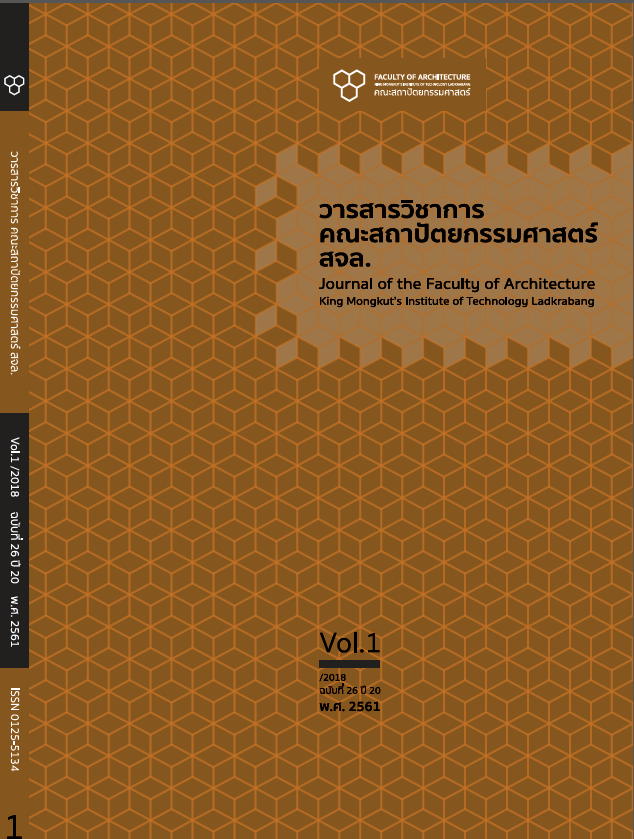การพัฒนาฝ้าชายคาระบายอากาศเพื่อลดความร้อนใต้หลังคาบ้านพักอาศัย, Development of Soffit Vents for Reduction of Heat Accumulation Under the Roof
Main Article Content
Abstract
Abstract
This research aimed to design and develop a prototype soffit vents that helps reduce the heat accumulationunder the roof. The scope of this research is to find the appropriate height of the soffit vents.
These soffit vents was designed in saw tooth shaped, able to prevent rain and insects. There are 3 types of soffit vents in this experiment. The control variables are shape, size and the arrangement of the soffit louver
and the independent variable is the height of each soffit vents which is 10mm, 5mm, and 3 mm.
The result shows that, at wind speed 2.0-2.8 m/s the speed after the wind passed through the soffits vents reduce less than wind speed 3.5-4.0 m/s. The soffit vents with 10 mm louver has the highest average
airflow at 0.54 m/s and the soffit vents with 5 mm and 3 mm louver has the average airflow at 0.43 m/s and 0.40 m/s respectively. The results of the experiment reveal that the most appropriate height of the louver for
a soffit vents is 10 mm. If this prototype soffit vents can be developed for practical use in the future, it could help reduce the heat accumulation under the roof much better than the soffit with no vent.
Keywords: Soffit Vents, Louver, Saw Tooth Shape Louver, Attic Ventilation, Wind Velocity
Article Details
This work is licensed under a Creative Commons Attribution-NonCommercial-ShareAlike 4.0 International License.
Copyright Transfer Statement
The copyright of this article is transferred to Journal of The Faculty of Architecture King Mongkut's Institute of Technology Ladkrabang with effect if and when the article is accepted for publication. The copyright transfer covers the exclusive right to reproduce and distribute the article, including reprints, translations, photographic reproductions, electronic form (offline, online) or any other reproductions of similar nature.
The author warrants that this contribution is original and that he/she has full power to make this grant. The author signs for and accepts responsibility for releasing this material on behalf of any and all co-authors.
References
เกษตรศาสตร์).
พันธุดา พุฒิไพโรจน์. (2550). การศึกษาประสิทธิผลในการลดความร้อนจากหลังคาโดยวิธีการระบายอากาศและการใช้ฉนวนกันความร้อน. วารสารวิจัยพลังงาน. 4(1). 59-72.
พาศนา ตัณฑลักษณ์. (2527). ภาวะภูมิอากาศกับการออกแบบอาคาร. กรุงเทพมหานคร: สำนักพิมพ์พิทักษ์อักษร.
วิกรม จำนงจิตต์. (2545). ประสิทธิผลของการออกแบบการระบายอากาศช่องใต้หลังคาเพื่อป้องกันการถ่ายเทความร้อนจากหลังคา. (วิทยานิพนธ์สถาปัตยกรรมศาสตรมหาบัณฑิต สาขาสถาปัตยกรรม บัณฑิตวิทยาลัย, จุฬาลงกรณ์
มหาวิทยาลัย).
วิทยา พวงสมบัติ. (2549 ก). การลดความร้อนสะสมในบ้านพักอาศัยโดยการระบายอากาศผ่านหลังคารับแสงอาทิตย์. วารสารส่งเสริมเทคโนโลยี. 33 (186), 168-171.
วิทยา พวงสมบัติ. (2549 ข). การลดความร้อนสะสมในบ้านพักอาศัยโดยการระบายอากาศผ่านหลังคารับแสงอาทิตย์. วารสารส่งเสริมเทคโนโลยี. 33 (187), 144.
วีระยุทธ พันธ์ศรี. (2556). อิทธิพลของมวลสารและองศาหลังคาต่อพฤติกรรมการถ่ายเทความร้อน. (รายงานการศึกษาอิสระปริญญาสถาปัตยกรรมศาสตรมหาบัณฑิต สาขาวิชาเทคโนโลยีอาคาร บัณฑิตวิทยาลัย, มหาวิทยาลัย
ขอนแก่น.


